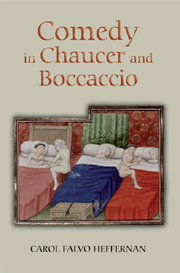Book contents
- Frontmatter
- Contents
- In memory Of Thomas Farel Heffernan 1933–2009
- Preface and Acknowledgments
- 1 Introductory matters
- 2 The Comic Inheritance of Boccaccio and Chaucer
- 3 Parallel Comic Tales in the Decameron and the Canterbury Tales
- 4 Antifraternal Satire in Boccaccio and Chaucer
- 5 Adding Comedy: Boccaccio's Filostrato and Chaucer's Troilus and Criseyde
- Conclusion
- Bibliography
- Index
- Chaucer Studies
5 - Adding Comedy: Boccaccio's Filostrato and Chaucer's Troilus and Criseyde
Published online by Cambridge University Press: 12 September 2012
- Frontmatter
- Contents
- In memory Of Thomas Farel Heffernan 1933–2009
- Preface and Acknowledgments
- 1 Introductory matters
- 2 The Comic Inheritance of Boccaccio and Chaucer
- 3 Parallel Comic Tales in the Decameron and the Canterbury Tales
- 4 Antifraternal Satire in Boccaccio and Chaucer
- 5 Adding Comedy: Boccaccio's Filostrato and Chaucer's Troilus and Criseyde
- Conclusion
- Bibliography
- Index
- Chaucer Studies
Summary
Chaucer's originality in using Boccaccio's Filostrato as his principal source for Troilus and Criseyde consists primarily in his introduction of comedy into the Italian's romance of unhappy love. The transformation of Pandaro, the go-between, into Pandarus, scheming architect of the love affair of Troilus and Criseyde, creates a fabliau thread in the English version that effects character dynamics between Pandarus and each of the lovers, moving them often in the direction of comedy. The comic aspect of the Troilus is not limited to fabliau. It includes the divine comedy of the hero's translation to the celestial eighth sphere, another innovation that Chaucer adds to his source, as well as the creation of a heroine with unique skills in coping with Fortune which contribute to her individual comedy. Chaucer, nonetheless, calls his poem a tragedy. That he ends the work by looking forward to a comedy to be written in the future suggests, however, that the poet was fully conscious of the impact of the comic strain of the Troilus and intended to repeat his success in the fabliaux of the Canterbury Tales. Pandarus, in particular, is a creation with as much power as the Pardoner or the Wife of Bath. Troilus and Criseyde is the subject of a chapter in an earlier book of mine about melancholia. I frequently include the work in a course I teach on medieval English romance literature.
- Type
- Chapter
- Information
- Comedy in Chaucer and Boccaccio , pp. 101 - 128Publisher: Boydell & BrewerPrint publication year: 2009



